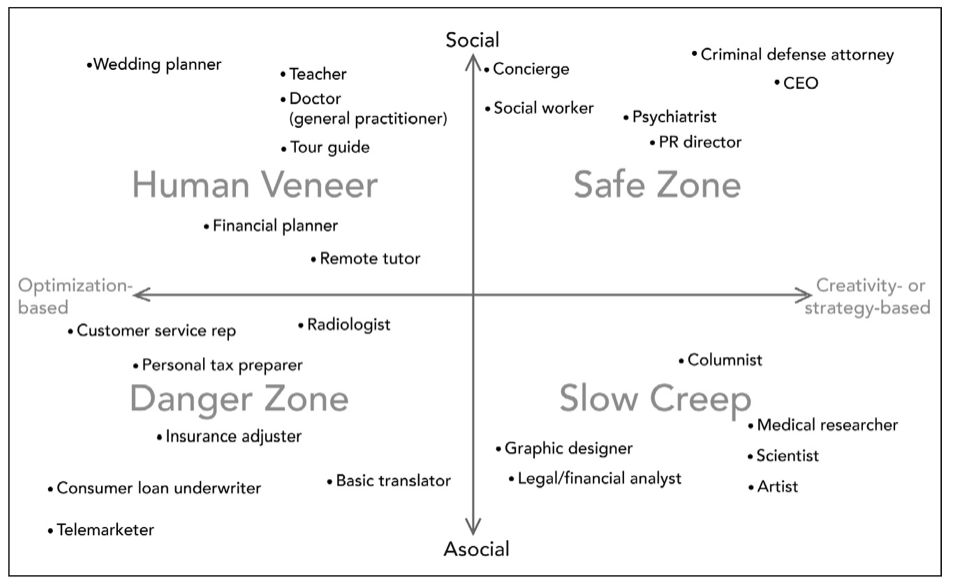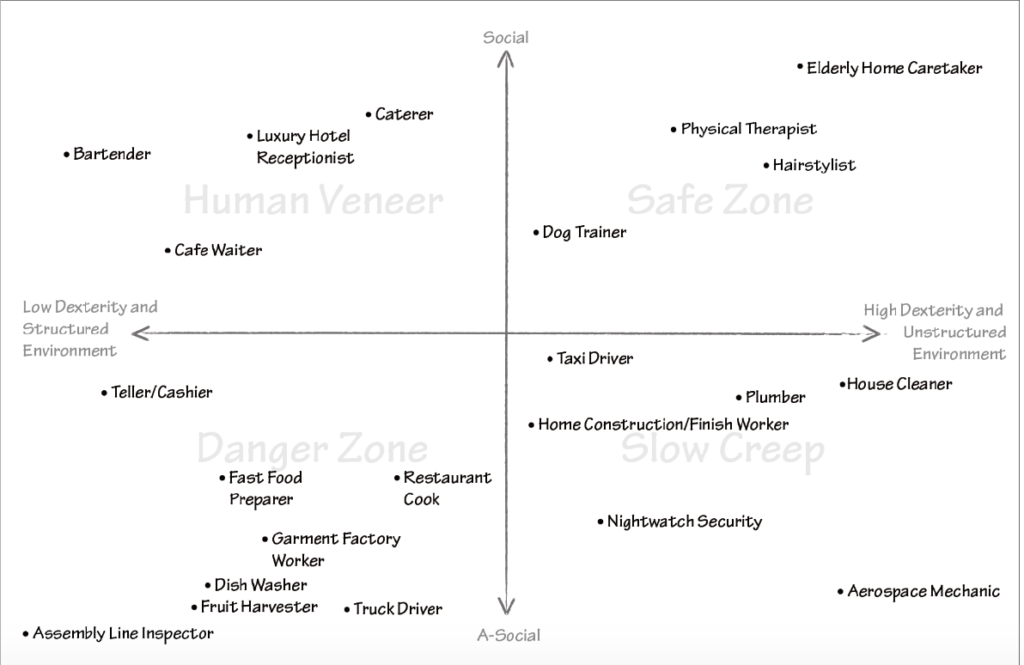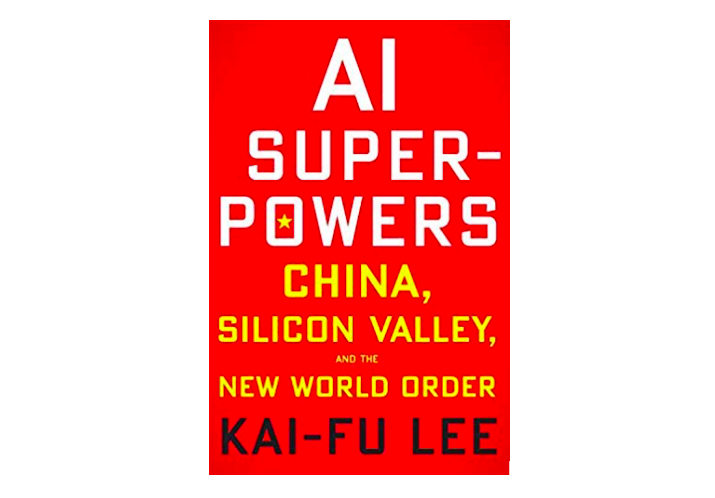AI Super-powers: China, Silicon Valley and the New World Order by Kai-Fu Lee is one of those books that entertains you and makes you learn at the same time. Although written a couple of years ago, it is a very appropriate read in these times of geopolitical disputes between the two AI super-powers, China and the US, and rising concerns about automation and job displacement. And like all great books, there is even some room for love…
Kai-Fu Lee was perfectly placed to write AI Super-powers. Born in Taiwan, he studied and worked in the US for many years, then moved to China. He has held executive positions at Apple, Microsoft and Google (he was the President of Google China), before founding his own VC company, Sinovation Ventures, to help develop Chinese high-tech companies. He has been at the forefront of the AI industry, both in Silicon Valley and China, so he has the right experience and background to make a fair assessment of the AI capabilities of both countries.
The rise of China as an AI Super-power
Lee argues that China is ideally placed to become the real AI super-power in the next few years. It has all the necessary elements to succeed in the age of implementation: quality and quantity of data, gladiator entrepreneurs, and a supportive government.
The great breakthrough in AI came in the mid-2000s with Geoffrey Hinton’s discovery to efficiently train new layers in neural networks, thenceforth also known as Deep Learning. Since then, all the news we receive about all the new exciting things AI can do is basically different applications of the same technology. We have passed the phase of breakthroughs in AI research and we are now in the age of implementation. We have passed from the age of inventors to that of tinkerers.
America has better AI researchers, and it has greater AI minds, but that’s not what will make the difference. Today data makes the difference. As the phrase goes, in the world of AI there is no better data than more data. It is better to have average AI engineers with plenty of data than an excellent AI researcher with no data at all.
China has more and better data. There are more internet users in China than in the US and Europe combined. Apart from this, in China, a new ecosystem of O2O (Online to Offline) businesses has spawned, whereby consumer order food, taxis, masseuses, hairdressers, and any other services you could think of, via an app. They also pay and transfer money to friends via apps, much more than in the US or Europe.
This means that Chinese companies have a trove of data on what their users do both online and offline, which is much richer than what their American counterparts get about their users’ activity online, mainly likes, shares, and positive reviews.

Then there is what Kai-Fu Lee calls the Chinese gladiatorial entrepreneurs. He pictures Silicon Valley entrepreneurs as some sort of idealists that want to change the world and become rich in the process by creating the perfect app or software to achieve something and then implementing it more or less the same way everywhere in the world. There may make some tweaks here and there, but everybody is supposed to have the same experience, be it in Japan or California.
Chinese entrepreneurs are very different. The Chinese market is cutthroat and hypercompetitive, with a lot of copying and quasi-illegal tactics, and the entrepreneurs that have thrived in this environment have done so by being very sensitive to consumer needs and tastes.
Silicon Valley entrepreneurs are often cavalier and don’t enter each other’s turfs. Chinese ones have no issues picking fights and competing with each other. This has toughened them up and made them better prepared to succeed in the future. This is what makes them “gladiatorial”.
The last element that supports China’s rise as an AI super-power is government support. In 2017 the Chinese government announced its plan to become the leading AI power by 2030 and since then it has been investing heavily to make this vision happen. As Lee explains in the book, when the Chinese leadership declares what its aims are, the whole apparatus of the government at all levels is put in motion to achieve that goal.
Kai-Fu Lee cites several times a report from PwC that estimates that AI deployment will add $15.7 trillion to global GDP by 2030. That’s more than China’s GDP at the time of writing. Out of this amount, China is predicted to take $7 trillion, whereas the US will only take a bit over half of that, $3.7 trillion. China does seem to be poised to be the winner of this battle.
Automation and inequality
Lee argues that Artificial General Intelligence (AGI) is still far away, maybe decades or even centuries away, so he doesn’t think we should worry (yet) about artificial superintelligence and its consequences.
His main worry regarding AI is the displacement of jobs by automation and the rising inequality this may cause. He believes there will be many disruptions and upheavals in the coming years and decades if we don’t manage well the transition towards a society with fewer jobs available.
This, of course, has been the main contention point also in other books reviewed on this site –A World Without Work by Susskind and The AI Economy by Bootle-, with different diagnoses and proposed solutions. Kai-Fu Lee’s are closer to Susskind’s.
He believes we will see great disruptions and upheavals and that the overall consequence will be the displacement of many jobs due to automation and the rise of inequality, both between countries and within them.
Out of the more than $15 trillion that will be added to the economy based on the PwC predictions mentioned above, around 70% will go to two countries only: China and the US. These two countries will win the lion’s share of the benefits created by the AI revolution, and the rest of the world will be playing catch up, but it will be an impossible task. As China and US-based companies attract all the talent and funding and amass all the data, their advantage over the rest of the countries will only grow over time, creating a new type of virtual bipolar world order.
Lee also argues that AI-related automation will undercut the economic card developing countries traditionally have played to climb the developing ladder: cheap labour. As robot-operated factories relocate closer to their consumers, what route will the developing countries use to grow into industrial middle-income countries?
Kai-Fu Lee believes that the new AI world order that is forming now will combine winner-take-all economics with unprecedented wealth concentration in the hands of a few companies in the two big AI super-powers. Thus, the key question is, if a big part of the wealth in the world is generated by a handful of companies based in just two countries, how is this wealth shared amongst the citizens of the world? This will be one of the key issues we will have to solve in the next decade or two.
He argues that many of the (relatively optimistic) predictions about the impact of automation on job displacement are based on research conducted in or before 2013, just before the big breakthroughs in Deep Learning came to life. Lee believes automation will make jobs disappear not only because tasks will be automated and people replaced by robots or AI, but also because there will be industry-wide disruptions, with the eruption of new AI-fuelled business models that may require less human labour.
Lee believes that the jobs requiring social interaction and the use of creativity or strategy for cognitive roles, or manual dexterity for physical ones, will be the jobs less subject to automation. Based on these two dimensions, he proposes two charts, for cognitive and physical labour, each of them with four distinct quadrants: the Safe Zone, the Slow Creep, the Danger Zone, and the Human Veneer. If your job is not in the Safe Zone you should start considering recycling your skills.


Love is what makes us human
After this, we enter the most personal and touching section of the book. Kai-Fu Lee tells us about his experience when he was diagnosed with cancer in a quite advanced stage and how he thought he was about to die. He is brutally honest about his regrets about the type of person he was (a workaholic, not paying enough attention and love to those who loved him) before this experience. This show of vulnerability and honesty is a very welcome and refreshing touch to the book.
During this ordeal, Lee realized that what really makes us humans and really matters in life is love and this is the one thing AI will never be able to replace. This was one of his big epiphanies during this dark period (the other one being that he had to spend more time with his family, which he now does):
“For all of AI’s astounding capabilities, the one thing that only humans can provide turns out to be exactly what is most needed in our lives: love.”
He believes this is part of the solution. We need to build a future that combines AI’s ability to think (so far narrowly, on specific tasks) with human beings’ ability to love and need to be loved. He suggests we should build our societies and organisations based on this. It won’t be easy (how do you build an organisation around love? How do you manage through love? Our current practices are so far from this approach…), but it will be our only way forward. It will be difficult but very rewarding.
Solutions
Kai-Fu Lee turns then into the solutions required for the risks brought about by automation and job displacement. He reviews the main fixes that others have proposed, which can be grouped into three areas: reducing working hours, retraining workers, or redistributing income. Lee explains in some level of detail these fixes, with their advantages and drawbacks, but he deems them more patches than structural and permanent solutions.
He believes the private sector must take the lead in creating the market symbiosis between AI and the more humanistic jobs powering it. Market forces will push for some of it, but for others, we will have to make conscious efforts as a society to push for them.
He highlights the push for more purposeful companies (something we agree on and promote on this site), but he might fall into an overly optimistic or naïve trap when considering how the private sector works and what sort of incentives help allocate investment and bring about deep behavioural changes.
He proposes a Social Investment Stipend for Care, Service and Education that will solve some of the shortcomings of a Universal Basic Income (UBI) by rewarding people for being more caring for others, for basically being more human. It is a similar solution to Susskind’s Conditional Basic Income.
Final words
We arrive at the question that really matters: should you read this book? Yes, you definitely should. It was published in 2018, which seems a short time ago, but a lot has changed since then, both in the relationship between the two AI super-powers, China and the US, and in the world at large, but it is still very relevant and insightful reading.
If you want to understand better the state of play between these two super-powers in terms of their AI capabilities, learn a bit more about China itself, its entrepreneurial culture and its digital ecosystem or learn about the risks of AI and automation from someone who has been at the forefront of AI research for decades, this is a book you will really appreciate.
Last but definitely not least, the book finishes with a message that resonates a lot with the Humane Future of Work website and our purpose: we human beings have agency, and we can and must write our own AI History. Amen.
